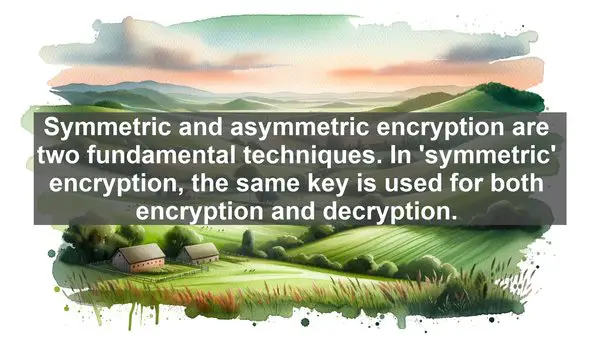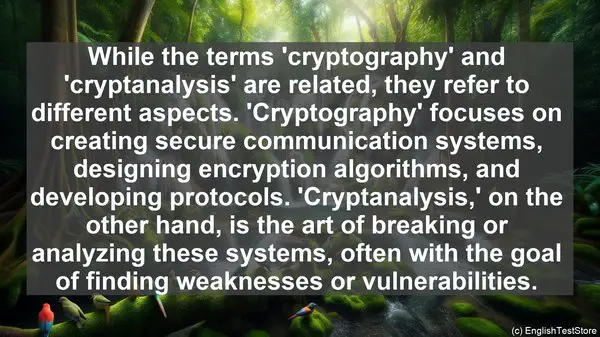Introduction to Cryptanalysis
Welcome to today’s lesson on the fascinating world of cryptanalysis. As students, it’s crucial to grasp the nuances of this field. One aspect that often trips up even seasoned analysts is the correct usage of certain words. In this lesson, we’ll explore the top 10 commonly confused words in cryptanalysis, ensuring you have a solid foundation in the language of codes and ciphers.
1. Cipher vs. Code
The terms ‘cipher’ and ‘code’ are often used interchangeably, but they have distinct meanings. A cipher is a method of transforming plaintext into ciphertext, while a code substitutes words or phrases with symbols. For example, the Caesar cipher is a well-known cryptographic technique, whereas the International Code of Signals is used in maritime communication. Understanding this difference is essential when analyzing encrypted messages.
2. Encryption vs. Decryption
When we talk about securing information, we encounter the terms ‘encryption’ and ‘decryption.’ Encryption involves converting plaintext into ciphertext, making it unreadable without the proper key. Decryption, on the other hand, is the process of converting ciphertext back into plaintext. Both are integral to the field of cryptanalysis, with analysts often focusing on breaking encryption schemes.
3. Key vs. Key Size
In cryptography, a ‘key’ is a piece of information used in conjunction with an algorithm to encrypt or decrypt data. It’s like a password that unlocks the encryption. Key size, on the other hand, refers to the length or complexity of the key. Generally, a longer key size implies stronger encryption, as it increases the possible combinations, making it harder to crack.
4. Brute Force vs. Dictionary Attack
When attempting to crack an encryption, analysts have different strategies. A ‘brute force’ attack involves systematically trying all possible combinations until the correct one is found. This method can be time-consuming and resource-intensive. In contrast, a ‘dictionary’ attack uses a pre-compiled list of commonly used words or phrases, significantly reducing the search space. Both approaches have their merits and limitations.
5. Symmetric vs. Asymmetric Encryption
Symmetric and asymmetric encryption are two fundamental techniques. In ‘symmetric’ encryption, the same key is used for both encryption and decryption. It’s like having a single key to lock and unlock a door. On the other hand, ‘asymmetric’ encryption involves a pair of keys: a public key for encryption and a private key for decryption. This method is often used in secure communication channels.

6. Cryptography vs. Cryptanalysis
While the terms ‘cryptography’ and ‘cryptanalysis’ are related, they refer to different aspects. ‘Cryptography’ focuses on creating secure communication systems, designing encryption algorithms, and developing protocols. ‘Cryptanalysis,’ on the other hand, is the art of breaking or analyzing these systems, often with the goal of finding weaknesses or vulnerabilities.

7. Plaintext vs. Ciphertext
In the world of encryption, we often encounter the terms ‘plaintext’ and ‘ciphertext.’ ‘Plaintext’ refers to the original, unencrypted message. It’s like a letter written in a language we understand. ‘Ciphertext,’ on the other hand, is the encrypted form of the message, transformed through a cryptographic algorithm. Understanding the distinction between the two is vital when analyzing encrypted data.
8. Steganography vs. Cryptography
While both steganography and cryptography deal with securing information, they do so in different ways. ‘Cryptography’ focuses on making the message unreadable through encryption. ‘Steganography,’ on the other hand, conceals the existence of the message itself. It’s like hiding a letter in a seemingly innocent painting. Both techniques have their applications in the realm of information security.
9. Hash Function vs. Encryption
A ‘hash function’ is a mathematical algorithm that takes an input and produces a fixed-size string of characters, often referred to as the ‘hash value’ or ‘digest.’ Unlike encryption, which is reversible, a hash function is designed to be one-way, meaning it’s computationally infeasible to derive the original input from the hash value. This property makes hash functions useful in various applications, such as password storage.
10. Cryptosystem vs. Algorithm
In the realm of cryptography, we often encounter the terms ‘cryptosystem’ and ‘algorithm.’ A ‘cryptosystem’ refers to the entire framework or system used for secure communication, including the algorithms, protocols, and key management. An ‘algorithm,’ on the other hand, is a specific set of steps or rules used for encryption or decryption. Understanding this distinction helps in comprehending the broader context of cryptographic systems.
